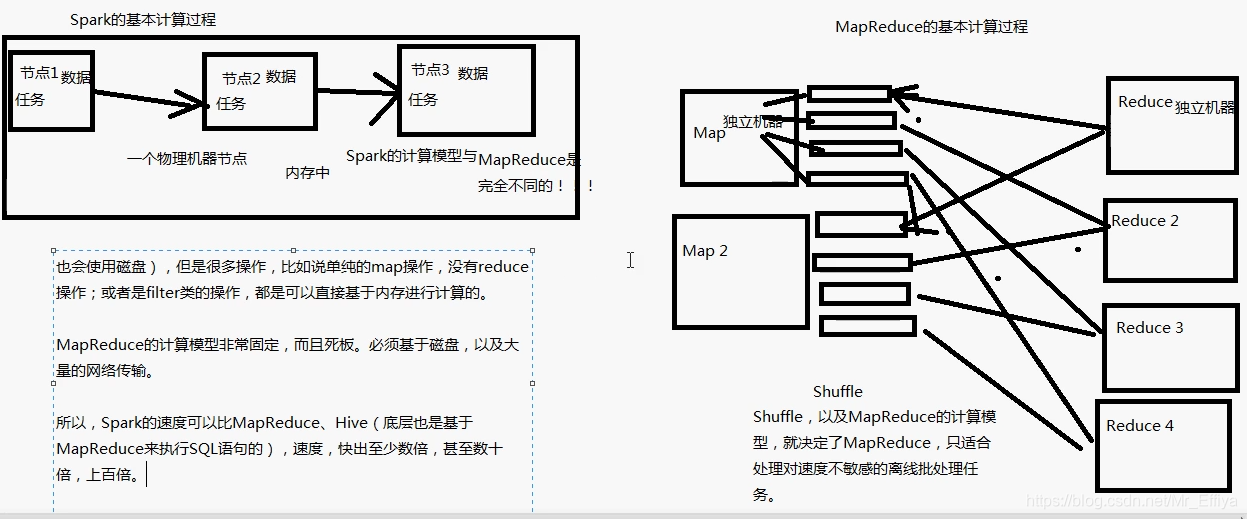一、Spark简介
1、Spark:完全基于Hadoop的一种计算框架

2、计算框架——》适用场景:
Spark RDD——》离线批处理
Spark Core——》流式计算
Spark SQL——》交互式查询(基于Hive)
Spark Streaming——》实时流式计算
Spark MLlib——》机器学习
Spark GraphX——》用于图计算
3、Spark用于计算,Hadoop生态系统用于存储(HBase,HDFS,Hive)、资源调度(Yarn)
4、Spark基于内存来计算,是MapReduce的数倍,即使是从磁盘读取计算,Spark计算速度也优于后者

对于数据量巨大的数据源,Spark处理会出现一些OOM内存泄漏等问题,但是MapReduce基于磁盘处理的就不会出现这种情况。
5、Spark整体架构

注:对弹性分布式数据集(resilient distributed dataset,简
称 RDD),RDD 表示分布在多个计算节点上可以并行操作的元素集合,是
Spark 主要的编程抽象
6、Spark SQL与Hive的区别

1)Spark SQL支持多种数据源,速度比Hive快(Hive将HQL翻译成MapReduce,还是基于MapReuce处理查询的)
2)部分Hive支持的高级特性,Spark SQL不支持。
spark sql不支持的hive功能(去官网看了下最新的2.3.2版本,不过2.4就快更新了,到时候再去看看)
Below is a list of Hive features that we don’t support yet. Most of these features are rarely used in Hive deployments.
以下是我们尚不支持的Hive功能列表。 大多数这些功能很少用于Hive部署。
Major Hive Features Hive的主要功能
Tables with buckets: bucket is the hash partitioning within a Hive table partition. Spark SQL doesn’t support buckets yet.
带buckets(桶)的表:bucket是Hive表分区中的散列分区。 Spark SQL尚不支持存储buckets。
Esoteric Hive Features 神秘的Hive功能
UNION type
Unique join
Column statistics collecting: Spark SQL does not piggyback scans to collect column statistics at the moment and only supports populating the sizeInBytes field of the hive metastore.
UNION类型
独特的加入
列统计信息收集:Spark SQL目前不会通过捎带扫描来收集列统计信息,只支持填充hive Metastore的sizeInBytes字段。
metastore
Hive Input/Output Formats Hive输入输出格式
File format for CLI: For results showing back to the CLI, Spark SQL only supports TextOutputFormat.
Hadoop archive
CLI的文件格式:对于返回到CLI的结果,SCALL SQL只支持ToTutuPuttFrand。
Hadoop存档
Hive Optimizations Hive优化
A handful of Hive optimizations are not yet included in Spark. Some of these (such as indexes) are less important due to Spark SQL’s in-memory computational model. Others are slotted for future releases of Spark SQL.
Block level bitmap indexes and virtual columns (used to build indexes)
Automatically determine the number of reducers for joins and groupbys: Currently in Spark SQL, you need to control the degree of parallelism post-shuffle using “SET spark.sql.shuffle.partitions=[num_tasks];”.
Meta-data only query: For queries that can be answered by using only meta data, Spark SQL still launches tasks to compute the result.
Skew data flag: Spark SQL does not follow the skew data flags in Hive.
STREAMTABLE hint in join: Spark SQL does not follow the STREAMTABLE hint.
Merge multiple small files for query results: if the result output contains multiple small files, Hive can optionally merge the small files into fewer large files to avoid overflowing the HDFS metadata. Spark SQL does not support that.
Spark中还没有包含一些Hive优化。由于Spark SQL的内存计算模型,其中一些(如索引)不太重要。其他版本用于未来的Spark SQL版本。
块级位图索引和虚拟列(用于构建索引)
自动确定连接和groupbys的reducer数量:目前在Spark SQL中,需要使用“SET spark.sql.shuffle.partitions = [num_tasks];”来控制后洗牌的并行度。
仅元数据查询:对于只能使用元数据来回答的查询,Spark SQL仍会启动计算结果的任务。
偏斜数据标志:Spark SQL不遵循Hive中的偏斜数据标志。
连接中的STREAMTABLE提示:Spark SQL不遵循STREAMTABLE提示。
合并多个小文件以查找结果:如果结果输出包含多个小文件,Hive可以选择将小文件合并为较少的大文件,以避免溢出HDFS元数据。 Spark SQL不支持这一点。
7、Spark Streaming与Storm
1)关于Storm

2)Spark Streaming不支持Storm的一种特性:分布式流式计算程序(Topology)在运行过程中,可以动态地调整并行度,动态提高并行能力。而且Spark Streaming属于准实时处理,如果对实时性要求比较高还是要用到Storm(其实现在阿里再用Flink,它是基于流式处理的,双十一的大屏幕就是用它做的,每秒可以处理4亿条数据)
3)Spark Streaming吞吐量比Storm高,因为是基于batch(批)的,而Storm对于每一条来的数据都要分配资源,导致Storm的吞吐量比较低。
4)Spark Streaming可以与Spark的其他框架相结合,可以对流式处理完的中间数据继续交给Spark其他框架来继续处理。
二、总结
至于MLlib和GraphX就在之后的学习的时候去查一下它们大致的一种情况吧。至于Spark的版本,将要迎来2.4.0版本,也新增了些功能,优于我初学Spark,先学习了Spark的基础之后,再去跟进最新的东西吧。